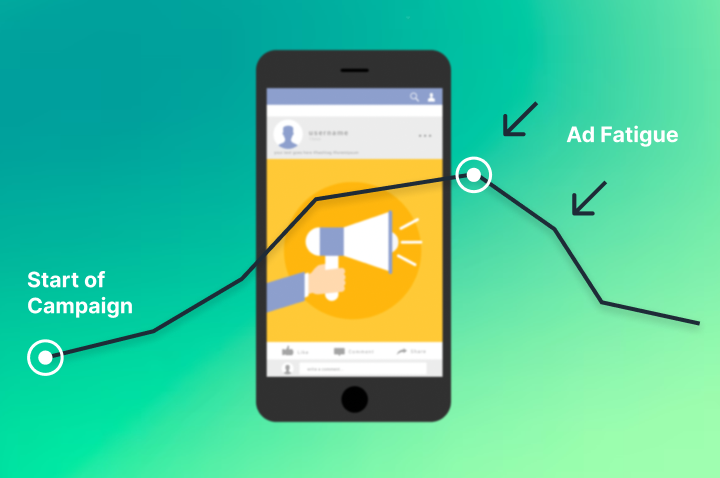Audience engagement is vital, but ad fatigue can pose a challenge. As your audience encounters a barrage of ads daily, their interest might wane. In this guide, we’ll explore uncomplicated strategies to sidestep ad fatigue. By comprehending your audience and implementing innovative methods, you can sustain their interest. This ensures your content remains captivating and relatable, cultivating enduring connections while averting the exhaustion that excessive ads can bring.
What is Ad Fatigue?
Ad fatigue refers to the phenomenon where an audience becomes desensitized or disinterested in advertisements due to repetitive exposure. When individuals are repeatedly exposed to the same or similar ads, they may start tuning them out, leading to a decline in engagement and effectiveness. This can result in reduced click-through rates, conversions, and overall audience interest. Ad fatigue highlights the importance of creating diverse, relevant, and timely ad content to maintain audience attention and prevent diminishing returns on advertising efforts.
How to Identify Ad Fatigue?
Identifying ad fatigue requires a keen understanding of your audience’s behaviors and monitoring key performance metrics. Here’s how:
-
Monitor Engagement Metrics:
A sudden drop in click-through rates, conversion rates, and overall engagement levels can indicate ad fatigue. Compare these metrics over time to spot significant declines.
-
Frequency Analysis:
Keep track of how frequently your ads are being shown to the same audience members. If the frequency is high, it could lead to ad fatigue as viewers see the same content repeatedly.
-
Audience Feedback:
Pay attention to comments, reviews, and messages from your audience. Negative feedback expressing annoyance or boredom with your ads might be a sign of ad fatigue.
-
Conversion Rate Changes:
If your ads have been successful in driving conversions but suddenly experience a dip, it might be due to ad fatigue. People may have grown tired of the same content.
-
Audience Segmentation:
Divide your audience into segments based on factors like demographics, interests, and behavior. If one segment shows significantly lower engagement, it could be experiencing ad fatigue.
-
Ad Decline Curve:
Monitor the performance of your ads over time. Initially, they might show good results, but eventually, a decline in effectiveness might signal ad fatigue.
-
Social Media Metrics:
On platforms like social media, a decrease in likes, shares, and comments can be indicative of ad fatigue, especially if your ads were previously generating high engagement.
-
A/B Testing:
Run A/B tests with new ad variations. If the new ads consistently outperform the old ones, it could indicate that the old ads were suffering from ad fatigue.
-
Surveys and Focus Groups:
Conduct surveys or gather feedback through focus groups to directly ask your audience if they’re feeling overwhelmed or disinterested in your ads.
Signs Your Ad is Experiencing Ad Fatigue
Ad fatigue can silently erode the effectiveness of your advertising efforts, leading to diminished returns and reduced audience engagement. Recognizing the signs of ad fatigue is crucial to ensuring that your ad campaigns remain impactful and efficient. Here are key indicators to monitor for:
-
Decreasing Return on Ad Spend (ROAS) and Less Engagement
A clear sign of ad fatigue is a decline in your Return on Ad Spend (ROAS), which measures the revenue generated from your ads compared to the money invested. When ad fatigue sets in, audiences become disinterested due to repetitive exposure, leading to reduced engagement levels.
Likes, shares, comments, and other interactions decrease as users become immune to the ad’s message. This lack of engagement directly impacts your ROAS, as the effectiveness of your ads diminishes, translating to lower revenue relative to your ad expenditure.
-
Increasing Cost Per Result
Ad fatigue can also be discerned from an uptick in your Cost Per Result (CPR). As fatigue sets in, your ad’s impact wanes, causing it to become less efficient in driving desired actions such as clicks or conversions.
Consequently, you’ll need to allocate more funds to achieve the same results that were previously accomplished with a lower budget. An increased CPR indicates that your ad is becoming less effective at motivating users to take the desired action due to familiarity or disinterest.
-
CTR Drop and Lower Click-through Rates (CTRs)
Click-Through Rate (CTR) estimates the percentage of users who connect to your ad after seeing it. Ad fatigue often leads to a drop in CTR as viewers become less motivated to engage with content they’ve seen multiple times.
A lower CTR means your ad isn’t effectively compelling your audience to take action, such as visiting your website or making a purchase. As your audience’s interest wanes, the likelihood of them clicking on your ad decreases, affecting your campaign’s overall success.
Top Ways to Avoid Ad Fatigue
Ad fatigue is a challenge that every marketer faces in the dynamic world of advertising. To ensure your campaigns maintain their effectiveness and engagement, implementing strategies to combat ad fatigue is crucial. Here are the top ways to keep your ads fresh and engaging:
-
Get Creative with Your Creatives
Regularly infuse creativity into your ad visuals and designs. Fresh and inventive creatives capture attention and prevent your audience from becoming disinterested due to repetitive visuals. This can involve experimenting with different layouts, color schemes, and imagery that align with your brand while providing a novel viewing experience.
-
Copy and Call-to-Action
Diversity and compelling ad copy and call-to-action (CTA) can combat ad fatigue. Experiment with distinct messaging that resonates with your audience’s emotions and needs. This approach keeps your ads feeling current and compelling, ensuring that the audience doesn’t grow weary of the same language.
-
Refresh Your Copy
Rotating your ad copy keeps it engaging and prevents monotony. Update headlines, descriptions, and value propositions to offer new perspectives and emphasize various aspects of your product or service. This practice ensures that your messaging remains dynamic and continues to resonate with your audience.
-
Expand Your Audience
Broaden your target audience to tap into new segments. This strategy prevents the overexposure of your ads to the same individuals and introduces fresh perspectives to your content. Exploring new demographics or interests can rejuvenate interest in your ads.
-
Decrease Your Budget
Temporarily reducing your ad budget can be effective in combating ad fatigue. Lowering exposure while you refine your approach allows you to maintain a balance between visibility and audience engagement. As you adjust your strategy, you can gradually increase the budget to reach the right audience effectively.
-
Manage Your Placements
Analyzing ad performance across various platforms and placements is essential. Focus on the channels that deliver optimal results, and consider adjusting or pausing placements showing signs of fatigue. A strategic approach to placements ensures your ads are seen in the right context, enhancing their impact.
-
Set a Custom Frequency Cap
Implement a frequency cap to control how often an individual sees your ad. By setting a limit, you prevent oversaturation and the potential annoyance that can result from excessive exposure. This cap ensures a positive user experience and prevents ad fatigue.
-
Dynamic Ads
Dynamic ads automatically adapt to user behavior and preferences. By providing tailored content, these ads maintain relevance and engagement. They prevent ad fatigue by delivering content that aligns precisely with the user’s interests and behaviors.
-
Use Video in Your Ads
Incorporating video content adds a dynamic element to your ads. Videos are inherently engaging and can convey messages more effectively than static images. This approach captivates the audience’s attention and helps combat ad fatigue by delivering content in an exciting format.
-
Monitor Your Campaigns
Continuous monitoring of campaign metrics is crucial. Regularly assess engagement levels, click-through rates, and conversions. Detecting any dip in performance enables you to take timely action to refresh your strategy and prevent ad fatigue from diminishing your campaign’s effectiveness.
Conclusion
In the journey of advertising, the ending is just as crucial as the beginning. Ad fatigue, while a common challenge, can be combated with strategic finesse. By weaving novelty into your strategies, you prevent monotony from setting in and eroding audience interest. As the curtains draw on this exploration, remember that vigilance and adaptation are your allies. Each tweak, each fresh idea, revitalizes your campaigns, forging an enduring connection with your audience. So, embrace creativity, tailor your approach, and keep your finger on the pulse of change. With these tools, your brand story shall resonate vibrantly, leaving ad fatigue in the rearview mirror.

